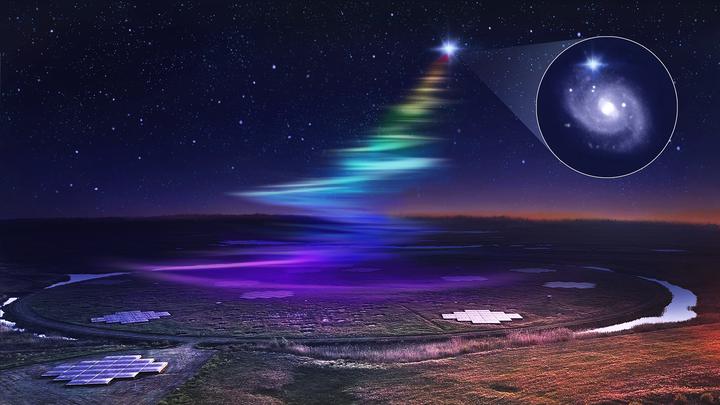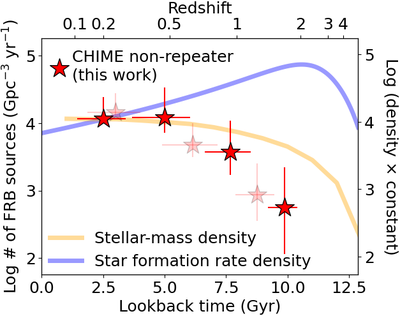 An artistic image of a fast radio burst (FRB). Image credit: [Daniëlle Futselaar/ASTRON/HST]
An artistic image of a fast radio burst (FRB). Image credit: [Daniëlle Futselaar/ASTRON/HST]
Fast radio bursts (FRBs) are mysterious millisecond pulses in radio, most of which originate from distant galaxies. Revealing the origin of FRBs is becoming central in astronomy. The most reliable method is to directly identify their progenitors by measuring the exact locations of FRBs in the sky. However, this has been difficult because such localization has to be carried out at the time of the FRB detection despite its extremely short timescale. A new method has been eagerly anticipated.
To overcome this problem, I focus on the cosmological history of the number density of FRBs. If FRBs originate from ‘young populations’, FRBs' number density should have been about one order of magnitude higher ~10 billion years ago (i.e. at the distant Universe) compared with that at present. This is because the number density of young populations such as magnetars, young pulsars, and supernova remnants have been higher by about one order of magnitude in the past in proportional to the cosmic star-formation rate density. Otherwise, the number density of FRBs would decrease towards the past (or distant) Universe in proportional to the cosmic stellar-mass density evolution. This case indicates that FRBs originate from ‘old populations’ such as white dwarfs, old neutron stars, and stellar-mass black holes because the stellar mass in the Universe is dominated by old objects. This method is free of the localization problem and provides a statistical point of view to the FRB origin.

I used homogeneous FRB samples selected from the new CHIME FRBs which were recently released. The number of samples is about one order of magnitude larger than that of previous works. As shown in the figure, I found that the number density of non-repeating FRBs significantly decreases towards the past (or distant) Universe (red stars) similarly to the cosmic stellar-mass density evolution. This decreading trend is in conflict with the cosmic star-formation rate density, indicating that the young population scenario is ruled out with a more than 99% confidence level. These results indicate old populations such as white dwarfs, old neutron stars, and stellar-mass black holes as the likely origin of non-repeating FRBs.
This article is based on the following publication.
Tetsuya Hashimoto, Tomotsugu Goto, Bo Han Chen, Simon C.-C. Ho, Tiger Y.-Y. Hsiao, Yi Hang Valerie Wong, Alvina Y. L. On, Seong Jin Kim, Ece Kilerci-Eser, Kai-Chun Huang, Daryl Joe D. Santos, and Shotaro Yamasaki, 'Energy functions of fast radio bursts derived from the first CHIME/FRB catalogue' , accepted for publication in Monthly Notices of the Royal Astronomical Society, (2022).